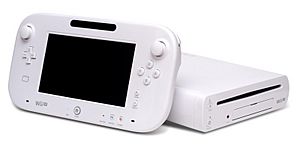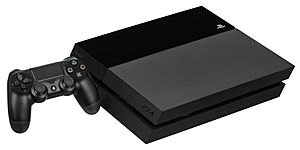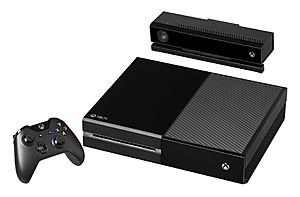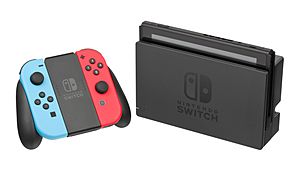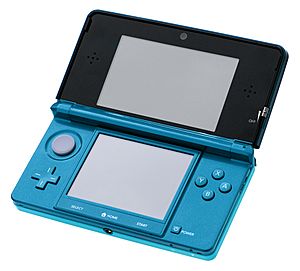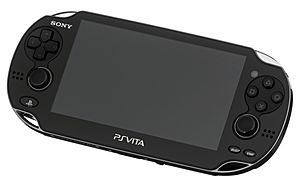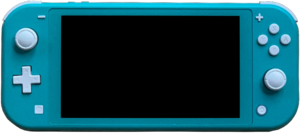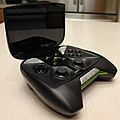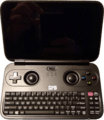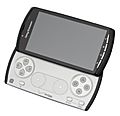Eighth generation of video game consoles facts for kids
The eighth generation of video game consoles started in 2012. It included popular home consoles like the Wii U (2012), the PlayStation 4 family (2013), the Xbox One family (2013), and the Nintendo Switch family (2017).
These consoles brought better performance, like faster processing and clearer graphics. They also made it easier to download games and play games online. While motion-controlled games were less popular, companies like Sony started looking into virtual reality (VR) with the PlayStation VR in 2016.
Sony focused on its own unique games to attract players. Microsoft offered services like Xbox Game Pass, which lets you play many games for a monthly fee, and xCloud for streaming games. Both Sony and Microsoft also released updated versions of their consoles, like the PlayStation 4 Pro and Xbox One X, which were more powerful. They also made smaller, cheaper versions like the PlayStation 4 Slim and Xbox One S. By 2021, the PlayStation 4 had sold about 106 million units, and the Xbox One had sold around 58 million.
Nintendo chose a different path. The Wii U was meant to be a stronger Wii, but it didn't sell well, reaching only 13.5 million units. This led Nintendo to release the Nintendo Switch in 2017. The Switch was designed to be played in many ways and quickly became very popular, selling over 125 million units by March 2023. Nintendo also released the Nintendo Switch Lite, a smaller version that works only as a handheld.
Handheld consoles faced tough competition from mobile games on phones and tablets. The Nintendo 3DS and 2DS did well, selling 75 million units. However, the PlayStation Vita sold only about 10 million units and was stopped in 2019. Nintendo also stopped making the 3DS in 2020. The Switch Lite is now seen as Nintendo's main handheld system.
This generation also saw China lift its ban on video game consoles in 2015, opening up a huge new market for game companies.
In November 2020, Sony released the PlayStation 5, and Microsoft released the Xbox Series X and Series S. These new consoles continued the trend of better performance and could play many games from the eighth generation.
How This Generation Started
This generation of consoles faced a new challenge: competition from smartphones and tablets. Many people started playing games on their mobile devices, and these games were often free. This meant that traditional console sales had to work harder to attract players.
The main consoles of this generation, the PlayStation 4, Xbox One, and Wii U, all used parts from the company AMD. The PlayStation 4 and Xbox One even used similar computer parts (called x86-64) to regular personal computers. This made it easier for game developers to create games for both computers and these consoles.
During this time, many smaller, simpler consoles called microconsoles also appeared. Some, like the Ouya, were based on Android. Others were tiny versions of older consoles, like the NES Classic Edition and SNES Classic Edition, which let you play classic games.
New ways to play games also came out, like Cloud gaming. This lets you play games over the internet without needing to download them. PlayStation Now and Microsoft's xCloud are examples of this. Google also launched Stadia, a service just for cloud gaming.
Moving to the Next Level
Video game console generations usually last about five to six years. However, the jump from the seventh to the eighth generation took about eight years. Interestingly, the Wii, which was the best-selling console of the previous generation, was the first to be replaced by the Wii U.
Microsoft and Sony initially thought their seventh-generation consoles would last ten years. They believed that new features like cameras and motion controllers (like Xbox's Kinect and PlayStation Move) extended their consoles' lives. But Nintendo decided to release the Wii U because sales of older home consoles were slowing down.
Mid-way through this generation, Sony and Microsoft released more powerful versions of their consoles, like the PlayStation 4 Pro and Xbox One X. These were not entirely new consoles but upgraded versions that offered better graphics and performance, especially for 4K TVs. This helped keep sales strong without making players buy a completely different system.
In 2020, Microsoft and Sony launched their ninth-generation consoles: the Xbox Series X and Series S and PlayStation 5. They wanted a smooth change, meaning the new consoles could play most, if not all, games from the previous generation. This made it easier for players to upgrade without losing their old games.
Gaming in China
The eighth generation also saw video game consoles return to the Chinese market. For many years, the Chinese government had banned the sale of game consoles because of worries about their effect on young people. This ban meant that PC gaming became very popular in China, with many internet cafes where people could play.
In 2014, China started to lift the ban, first in a special trade zone, and then completely by 2015. This was a huge opportunity for game companies, as China had an estimated 500 million potential players.
Microsoft and Sony quickly jumped into the Chinese market. Microsoft partnered with a local company to sell the Xbox One, and Sony worked with another company to bring the PlayStation 4 and PlayStation Vita to China. Nintendo also teamed up with Tencent in 2019 to sell the Nintendo Switch in China and help its games get approved by the government.
Home Consoles
Wii U
Nintendo announced the Wii U in 2011 as the successor to the popular Wii. It was the first console of the eighth generation, released in November 2012 in North America.
The Wii U's main feature was its unique controller, the Wii U GamePad. This controller had a touchscreen built into it. You could use it as a second screen for games, or even play games directly on the GamePad without needing a TV. The Wii U could also use old Wii accessories like the Wii Remote Plus and Wii Nunchuk.
The Wii U came in two versions: Basic and Deluxe. Nintendo expected to sell over 100 million units, like the Wii. However, the Wii U only sold about 13 million units, making it Nintendo's least successful home console. Because of its low sales, Nintendo stopped making the Wii U in January 2017, just before the Nintendo Switch came out.
PlayStation 4
Sony announced the PlayStation 4 in February 2013. It was released in North America in November 2013 for $399.99.
The PlayStation 4 focused a lot on social features. Players could easily share videos of their gameplay or stream their games live on services like Twitch. The DualShock 4 controller was similar to the previous one but added a touchpad and a "Share" button. Sony also offered the PlayStation Camera accessory, which could track motion like Microsoft's Kinect. You could also use your PlayStation Vita or mobile apps as a second screen for some games.
Xbox One
Microsoft announced the Xbox One in May 2013. It was released in North America in November 2013 for $499.99.
The Xbox One was designed to be an entertainment hub, not just a game console. It could connect to your TV and let you switch between games, TV shows, and apps like Skype. The controller had "Impulse Triggers" that vibrated to make games feel more real. An improved Kinect sensor was also developed, which could understand voice commands.
Microsoft later released two updated versions: the cheaper Xbox One S in 2016 and the more powerful Xbox One X in 2017, which supported 4K gaming. Microsoft stopped making the Xbox One family of consoles in late 2020 after the new Xbox Series X and S were released.
Nintendo Switch
After the Wii U's struggles, Nintendo wanted to create a new console that would appeal to many different players. They announced the Nintendo Switch in 2016, and it was released worldwide on March 3, 2017.
The Switch is unique because it's a "hybrid" console. You can play it like a home console by putting the main tablet-sized unit into a dock connected to your TV. Or, you can attach two small controllers called Joy-Cons to the sides of the tablet and play it as a handheld device. You can also use a kickstand on the back of the tablet to play with friends on the go.
Even though the Switch wasn't as powerful as the PlayStation 4 or Xbox One, it was a huge success. Nintendo sold over 17 million units in its first year, quickly surpassing the Wii U's total sales. It became the fastest-selling console of the eighth generation in the US.
Nintendo later released the Nintendo Switch Lite in 2019, which is a smaller, cheaper version designed only for handheld play. In 2021, they released the Nintendo Switch – OLED Model, which has a bigger, brighter screen and other improvements.
Handheld Systems
The eighth generation saw a big change for handheld gaming. More and more people started playing games on their smartphones and tablets. This made it harder for dedicated handheld game consoles to sell as many units as they used to.
Nintendo 3DS
The Nintendo 3DS is a portable game console made by Nintendo. It came after the Nintendo DS. The cool thing about the 3DS is that it could show 3D images without you needing to wear special glasses!
The Nintendo 3DS was released in Japan in February 2011 and in other parts of the world in March 2011. It could also play games from the older Nintendo DS systems.
Nintendo later released several different versions of the 3DS:
- The Nintendo 3DS XL (2012) had much bigger screens.
- The Nintendo 2DS (2013) was a cheaper, flatter version that didn't have the 3D feature.
- The New Nintendo 3DS and New Nintendo 3DS XL (2014) had a faster processor, better 3D, and an extra small joystick called the C-stick.
- The New Nintendo 2DS XL (2017) was a thinner, clamshell version of the 2DS.
The entire 3DS family of systems was officially stopped in September 2020.
PlayStation Vita
The PlayStation Vita was Sony's second handheld game console, following the PlayStation Portable. It was released in Japan in December 2011 and in North America and Europe in February 2012.
The Vita had two analog sticks, a 5-inch OLED or LCD touchscreen, and supported Wi-Fi and even 3G in some models. It had a powerful processor and graphics chip. You could also play some older PlayStation Portable and PlayStation 1 games on it.
Sony didn't release exact sales numbers for the Vita, but it's estimated to have sold around 15-16 million units. Sony stopped making the PlayStation Vita in March 2019 and has no plans for a new handheld console.
Nintendo Switch Lite
Nintendo released the Nintendo Switch Lite worldwide on September 20, 2019. This version of the Switch was designed to be cheaper and more portable.
The Switch Lite has the Joy-Con controllers built right into the main unit, so they can't be removed. This means it can only be played as a handheld device and cannot be connected to a TV. It's also smaller and lighter than the regular Switch and has better battery life. The Switch Lite can play almost all Nintendo Switch games, except for a few that require the detachable Joy-Cons or TV mode.
Images for kids
See also
 In Spanish: Videoconsolas de octava generación para niños
In Spanish: Videoconsolas de octava generación para niños


